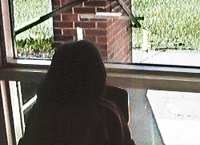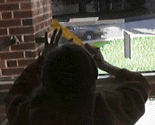Classroom Activity: Using Leonardo's Window
Main Idea: Students use a glass
window as a canvas. Looking through one eye they can trace the
outlines of objects seen through the window to create a drawing with
natural and correct perspective.
Learning Objectives:
- To become more aware of perspective.
- To learn and apply a Renaissance technique for creating proper
perspective in drawing a scene.
Time Needed: 30 minutes
Materials:
- windows with views
- sheets of acetate
- masking tape
- straight backed chairs
- eye patches or bandanas
- white board or overhead markers
- straight edges
- white paper, a copy of Exploring
Linear Perspective for easy reference.
Teacher Notes:
- If your school has lots of large windows with views, and a
large number of portable chairs, all your student may be able to
do this activity at one time. More likely you will want to explain
the procedure and then have a few students try it at a time.
If the windows are cold, the markers you use may act as if they
are out of ink. Holding them point down and breathing warm air on
the points will revive them.

 Procedure:
Procedure:
- Place the chair close to the window but facing backwards.
- Sit with your legs around the chair back.
- Tape the acetate to the window centered at eye level.
- Cover one eye with a patch or bandana.
- Rest your chin on the middle of the chair back and try hard to
keep your head absolutely still.

- Carefully trace the outlines of the objects you see through
the window. You may want to use a straight edge when tracing
straight lines.
- If you stop to rest, be careful not to move the chair and be
sure to put your head back in exactly the same place.

- When you have finished your tracing, remove it from the window
and tape it to white paper.
Going Further:
- If you place white paper on top of your tracing while it is
still taped to the window, you can trace the tracing in pencil or
another medium to make a more permanent drawing. You may want to
add people, animals, plants or buildings to create your own
version of the scene. If you wish, color it with paint or
crayons.
Students can exchange tracings and try finding the exact spot each
was drawn from. They can check their predictions by aligning the
tracing on the window and looking with one eye to be sure the
drawing's lines match those of the objects outside.
Exploring Your Own Perspective:
- Before answering these questions students will need to look at
the Exploring Linear
Perspective web page.
- Where is the horizon line
in your picture? Looking back at the original view may help you
locate it.
- Can you find any lines or pieces of lines coming closer
together as they approach the horizon line? These are orthogonal
lines. Can you find the vanishing
point? If you aren't sure where it is, try using a straight
edge to extend any receding straight lines you find until they
meet at the horizon line.
Alison Cole's book Eyewitness Art: Perspective is a
fascinating resource on this topic for students who want to learn
more.
Science Learning Network / email: sln@mos.org / © 1997
The Museum of Science

 Procedure:
Procedure: 
 Procedure:
Procedure: 
